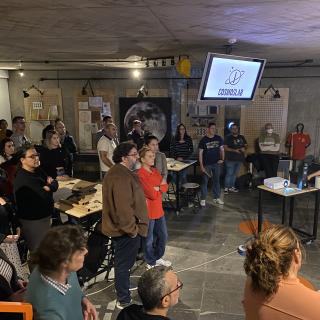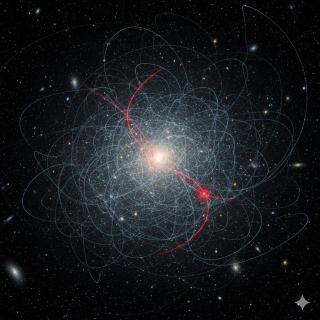Gas is essential to the process of forming a galaxy. During the first stages the amount of gas present determines the number of stars which will be in the galaxy. The galaxies with active nuclei (AGN) are those with a region of intense brightness in their centres. This brightness is produced by the presence of a supermassive black hole whose gravity makes it accumulate matter around it, in a process known as accretion.
Supermassive black holes cause the surrounding gas to heat up, and some of it is driven towards the outer part of the galaxy (feedback effect). Until now it was believed that the AGN with lower luminosity did not produce enough energy to expel large quantities of gas. But an international study, in which two researchers from the Instituto de Astrofísica de Canarias (IAC) took part, show that this is not the case.
In the article, published recently in the scientific journal Monthly Notices of the Royal Astronomical Society, they analysed the galaxy ESO 428-G14, which has a low luminosity AGN. Thanks to the data obtained with the integral field spectrograph SiNFONI on the Very Large Telescope (VLT) of the European Southern Observatory (ESO) they found that this galaxy shows the strongest feedback effect yet seen in an object of its class.

"In this low luminosity galaxy" explains Daniel May, a researcher at the Institute of Astronomy, Geophysics and Atmospheric Sciences at the University of Sao Paulo, and first author on the paper, "the jet is instrumental in driving the gas outwards, but in the more luminous active nuclei this task is performed by the radiation emitted by the nucleus itself".
Radiogalaxies, which are AGN with very powerful jets, drive out material at rates of between 1 and 50 solar masses per year. ESO 428-G14, which has a weak jet, does this at a rate in the range 3-8 solar masses per year. "With these data" comments Almudena Prieto, an IAC researcher and co-author of the article, "it is the faintest galaxy with the strongest feedback observed until now".
"Our results open up a debate about the role of supermassive black holes as efficient motors at the heart of galaxies, independently of their luminosity" states Alberto Rodriguez Ardila, a visiting researcher at the IAC and a co-author of the article.
In future research the team of scientists will try to discover the nature of the process which makes it possible for a nucleus which is as faint as that of ESO 428-G14 to be so efficient in expelling gas. "It is probable that it is related to the origin of the gas itself in the galaxy" notes May.
Article:
D. May et al. “Powerful mechanical-driven outflows in the central parsecs of the low-luminosity active galactic nucleus ESO 428-G14. En: https://academic.oup.com/mnrasl/article/481/1/L105/5079641
Contacts:
- Almudena Prieto: aprieto [at] iac.es (aprieto[at]iac[dot]es)
- Alberto Rodríguez Ardila: aardila [at] lna.br (aardila[at]lna[dot]br)
![Imagen de la región más interna de ESO428-G14 en la línea de [SiVI] solapada con la emisión del jet (contornos en azul) en radio. Los números 1 a 6 denotan las regiones donde la emisión del jet es más intensa. La región 1 coincide con la posición del AGN. Crédito: D.May et al. Imagen de la región más interna de ESO428-G14 en la línea de [SiVI] solapada con la emisión del jet (contornos en azul) en radio. Los números 1 a 6 denotan las regiones donde la emisión del jet es más intensa. La región 1 coincide con la posición del AGN. Crédito: D.May et al.](/sites/default/files/styles/crop_rectangle_21x9_to_1280/public/images/news/img_prensa_prensa1516_3580_hi.jpg?h=1e2fb94b&itok=aU4rTAAr)


